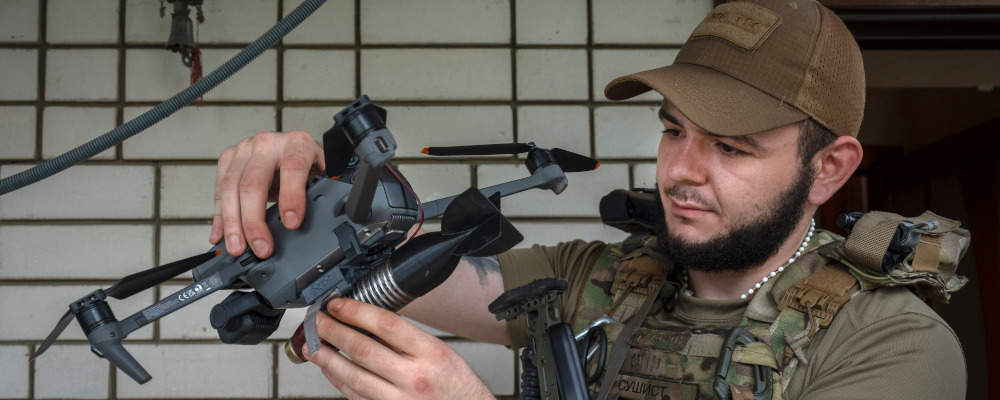Historically, certain wars have stimulated the development of future defence thinking. The 1905 Russo-Japanese War previewed many features of the Great War a decade later, including the lethality of machine guns and howitzers, as well as the ubiquity of trench warfare. The 1973 Yom Kippur War between Israel and its Arab Neighbours was particularly influential for present wars—the Arab combatants’ use of new anti-tank guided missiles challenged many existing doctrines. This is not to say that all groups absorb the lessons directly or effectively. Many of the great powers, including Russia (who fought in the 1905 war), failed to adopt the lessons laid bare in that conflict and suffered grievous casualties in the first years of World War I as a result.
Approaching two years since the invasion, the war in Ukraine has the potential to have an outside impact on the future of war for a variety of reasons. Its timing comes as a number of new technologies have emerged, many of which have come from the civilian space. These include the proliferation of drones, low-cost satellites, and high bandwidth networking—all of which to date have had major effects on the outcome of the war.While earlier conflicts, such as the Armenian-Azerbaijan war of 2021, or the war against ISIS from 2014 onwards, featured these systems, they were not employed in such a comprehensive fashion as they are currently in Ukraine. This was partly the result of one or more of the combatants’ lack of resources, but the scale and length of the conflict are also important. Over the past two years, both sides have adapted their doctrine and capabilities to reflect a cycle of learning and adaptation which gives a clearer understanding of where these technologies are headed.
Some of these trends are a validation of overriding trends in warfare, particularly around the collection and use of data afforded by networked systems. This is evident in the maturation of the “reconnaissance-strike” complexes in Russian and Ukrainian doctrine. Essentially, this is a streamlining of the process of identifying and attacking targets with precision fire, usually from some form of artillery. The United States and NATO have been pursuing a roughly similar—but much more advanced and all-encompassing—concept known as “multi-domain operations.” There are several common denominators between both doctrines, including the effort to expand detection over wider areas, as well as hastening the decision-making process which can improve the lethality of any weapon system attached to it. While it may not be able to employ traditional airpower, the use of long-range artillery (including the recently provided ATACMS missile system) shows the effectiveness of this approach to war. It also allows for a greater economy of force—a critical consideration for Ukraine due to its disadvantageous economic and strategic situation facing a state three times its size.
A key feature of progress in this area is its organic nature. Since the start of direct hostilities in 2014, Ukraine has done well to build up some of these connective capabilities adapting civilian systems for military purposes, such as the Starlink satellite network and apps for mobile devices. A large portion are ground-up approaches, developed even by military units to suit their particular operational needs. This was part of the total war approach that the Ukrainian government has instituted, often leveraging their emerging tech industries to develop new capabilities to fight against the Russian Federation. Many allies have similar efforts, but too often focus remains on a very centralized, top-down approach, which has led to substandard outcomes. Some balance between the two poles is likely ideal.
Another major consideration is the revolutionary impact of drones on air warfare. Traditional manned airpower, like F-16, Mig-29s, and even attack helicopters, remain as relevant as ever in Ukraine. While no side possesses true air superiority, some localized control has been established for short periods, resulting in potentially decisive consequences. However, the war has followed the trend of other recent wars with low-cost, attritable drones playing an important role. While this has been evident in the strike-reconnaissance doctrine discussed above, the so-called kamikaze loitering drones, such as the Russian Lancet and armed first-person view commercial drones, have played an important role as well.
One important aspect is what is known as the “mass” of these capabilities—not individually, but as a collective system or swarm of multiple individual units that can be lost without a major degradation of their lethality. At present, the link between traditional and emerging airpower domains is fairly disjointed over the battlefield in Ukraine, perhaps due to lingering service parochialism. But once combined they will only multiply each other’s lethality.
There is, however, one question concerning this new frontier of airpower’s ultimate influence in the future. It hinges significantly on the efficacy of new anti-drone systems, like those being developed by the United States Army and NATO allies. These potentially may blunt or even remove the deadly threat these UAVs pose to modern ground forces. But as of now they are in their infancy and very few are present in Ukraine today. If they are unable to make a major impact, then the future of conflict will be radically different.
Over the past thirty years, Canada, the United States, and its allies have often been able to deploy troops abroad to many stabilization and peacekeeping missions, in part due to the relatively benign threat environment they were entering. There was confidence that deployed soldiers would not incur significant casualties, which would arouse domestic opposition to the missions themselves. If the lethality of these unmanned drone systems remains unchecked, then, considering their greater ubiquity, it may drastically constrain the ability of Western countries to intervene and assert their muscle abroad, even in low-risk environments.
Finally, and perhaps most critically, is the need for an adaptive defence industrial base (another word for military supply chains) with the capacity to meet a wide need for war. The Russian Federation, for example, faced wide-ranging and intrusive sanctions from the start of the conflict that precluded them from obtaining a number of key resources for their war effort, ranging from raw materials to advanced technology components. They have been able to weather these challenges due to a combination of factors: a deliberate effort to develop an autarkic industrial base that started after 2014, a less technologically advanced military, and sanctions-avoiding policies such as smuggling and diversifying their foreign supplier base to more reliable allies.
While Western allies are unlikely to face the same restrictions in a potential future conflict on the scale that Russia has, in some ways they have greater challenges. These countries rely on much more sophisticated military capabilities that have levels of complexity far in excess of Russian systems. The sheer diversity in all of the raw materials inputs and various subcomponent providers, as well as the networks to make them all work, means that they are actually much easier to disrupt. Shades of this were evident during the initial months of the COVID-19 epidemic when the production of civilian goods was affected by shortages and supply chain disruptions.

Furthermore, underinvestment in the defence industrial base has left the capacity to ramp up production in most areas perilously slow, even two years after the conflict started.
More effort must be spent on creating a much more resilient industrial base that has the capacity to ramp up production to meet the needs of modern war. This requires significant front-end investment by governments in capacity building as no private firm is willing to spend money in that fashion without any guarantee of a return. At the same time, building capacity must be targeted and appropriate to the actual needs of Canada and its allies—taking lessons from Ukraine without understanding their context would be a mistake. That war and its material demands are unique to it.For example, the first several months saw a massive need for man-portable anti-tank guided missiles like the Javelin and N-LAW, because that was the only system available at the time. Allied states, on the other hand, possess a wide diversity of different systems available to fight such a conflict. While more production capacity for anti-tank systems is necessary, it may not be as much as the conflict in Ukraine suggests. Discerning the actual needs and developing accordingly should be done through careful analysis and wargaming, much like the recent Center for Strategic International Studies analysis on U.S. missile needs in a potential war against China has done.
In the end, a clear trend that seems to bind all of these areas is the need for adaptability and critical thinking. Warfare is fast becoming more lethal and decisive. Modern armies must be able to respond to those changes as quickly as they occur—or better yet, lead those changes against their adversaries. That, for one, cannot occur in an organization that is continually starved for funding like the Canadian Armed Forces is today.
But it may also require a radical reorganization and re-think of how defence policy, strategy, operations, and doctrine are developed and implemented—not to mention personnel and industrial policy. As the conflict in Ukraine has laid bare, bringing in the brightest minds and giving them greater leeway to develop responses is key, as is harnessing the potential and building the capacity of domestic industrial bases. These are essential and urgent lessons we must learn. They have been hard won by the sacrifices of the Ukrainian people for our benefit. It would be a shame to waste them.
Recommended for You

RCMP spending to protect MPs may have risen 112% since 2018, as Canadian politicians face greater rise in threats

Scott Stirrett: The time has come for mandatory national service for young Canadians

Geoff Russ: A future Conservative government must fight the culture war, not stand idly by

David Mulroney: Foreign Minister Joly, Xi Jinping’s China doesn’t do ‘dialogue’













